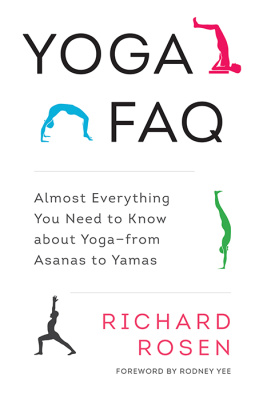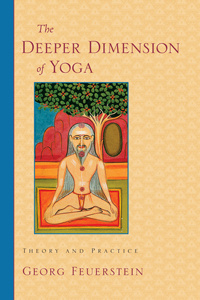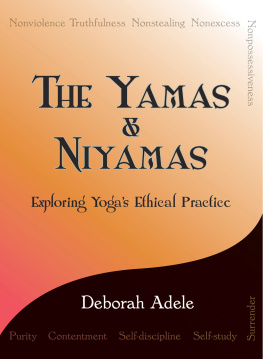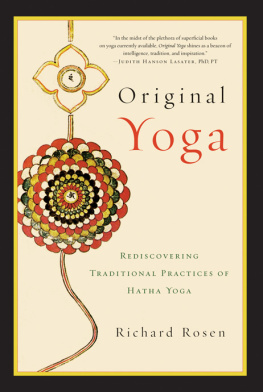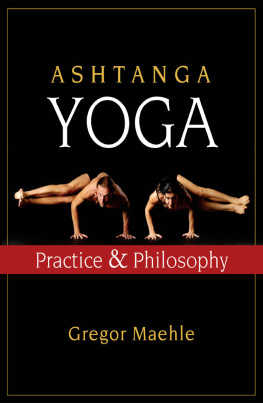Richard Rosen is one of the most thoughtful, generous, funny, humble, and researched fellas that I know. Yoga FAQ is a testimony to Richards character as a man and diligence as a yogi. The content is for anyone that is not satisfied with being a blind follower. Richard has done the research and held the debates to debunk unsubstantiated yoga myths that we deem as fact. His curiosity and inability to be satisfied with superficiality have brought us a text that will leave many of us scratching our heads and maybe even feeling a little defensive as our beliefs are being tested. This is important stuff for anyone that craves to see what is below the surface of the yogic teachings. If we keep asking the questions, maybe we might get a glimpse of how these practices can bring about true happiness.
COLLEEN SAIDMAN, author of Yoga for Life
Richard Rosen has crafted a delightful book that showcases equally both his academic knowledge about yoga and his gentle sense of humor. Yoga FAQ is a clear resource that helps us to formulate and understand our big questions about yoga and spiritual practice. I felt as if I were tucking into the personal story of Mr. Rosens own journey studying yogaand the trip was intriguing and fun. Highly recommended for all levels of students and especially for yoga teachers.
JUDITH HANSON LASATER, PhD, PT, author of Relax and Renew and Yoga Body
Yoga FAQ is an indispensable addition to any yoga enthusiasts shelf. Fact-filled and scholarly, this book makes you feel like the author is sitting across from you, sipping tea and patiently answering your every query. Richard Rosen has a remarkable way of honoring the great traditions and the newer expressions of yoga, with just enough humor and irreverence to keep you turning page after page.
ANNIE CARPENTER, creator of SmartFLOW Yoga
Richard Rosen is one of the wisest, warmest, and funniest writers I know, as well as being one of the most skilled and learned yoga teachers in America. In this book he brings all of those qualities to bear on some of the topics that routinely confuse students of yoga, new and old. A great service.
MARK SINGLETON, author of Yoga Body: The Origins of Modern Posture Practice and Roots of Yoga
Sign up to receive news and special offers from Shambhala Publications.

Or visit us online to sign up at shambhala.com/eshambhala.
YOGA FAQ

Almost Everything You Need to Know About Yogafrom Asanas to Yamas
RICHARD ROSEN

SHAMBHALA
Boulder
2017
Shambhala Publications, Inc.
4720 Walnut Street
Boulder, Colorado 80301
www.shambhala.com
2017 by Richard Rosen
Cover art Shutterstock
Cover design by Katrina Noble
All rights reserved. No part of this book may be reproduced in any form or by any means, electronic or mechanical, including photocopying, recording, or by any information storage and retrieval system, without permission in writing from the publisher.
Designed by Steve Dyer
LIBRARY OF CONGRESS CATALOGING-IN-PUBLICATION DATA
Names: Rosen, Richard, author.
Title: Yoga FAQ: almost everything you need to know about yogafrom Asanas to Yamas / Richard Rosen.
Description: First Edition. | Boulder: Shambhala, 2017. |
Includes bibliographical references and index.
Identifiers: LCCN 2016011783 | eISBN 9780834840577 | ISBN 9781611801736 (pbk.: alk. paper)
Subjects: LCSH: Hatha yoga.
Classification: LCC BL1238.56.H38 R673 2016 | DDC613.7/046dc23
LC record available at https://lccn.loc.gov/2016011783
Many of the old Hatha Yoga books open with a salutation delivered by the books author or compiler. The purpose is to acknowledge his indebtedness to his teacher, whether he be human or divine, whos credited as the ultimate source of the material about to be presented. The salutation might begin with the Sanskrit word shri, which has a wealth of meaningradiance, splendor, glory, beauty, grace, prosperity, success, auspiciousness, among many othersthough typically its meant as a title of respect, even reverence, for the man or deity so invoked.
In keeping with this long tradition, shri, Id like to dedicate this book to the memory of Georg Feuerstein (19472012). Georg was never officially my guru; I seriously doubt he would have accepted that role. But over the fifteen years I knew him, thats how I secretly thought of him, and still do today. Hardly a day goes by that I dont look into one of his many books to draw inspiration from the immense store of his wisdom. Hell be quoted and referenced often with great affection and respect in the pages that follow.
O Parvati, nothing is so fruitful, pleasing, subtle, mysterious, enlightening, and lovely as yoga.
Seed of Yoga (Yoga Bija), verse 81
Contents
FRIENDSHIP IS ONE OF THE great human gifts, and a long, enduring friendship is sheer beauty and grace. Richard Rosen has been my dear friend for more than thirty years, and all that time I have depended on him for advice, wisdom, understanding, and just plain fun.
So what is he offering up in this latest book? One afternoon a few years ago, we sat in his book-lined office and talked about all the misconceptions circulating in the yoga community. I suggested to him that his next book should address these modern-day misconceptions, and now, after hours and hours of research, long days huddled over his computer, andas he tells methree missed deadlines, hes finally delivered what I asked for.
The book starts by addressing some of the most basic yoga questions, and Richards research leads to some startling discoveries. What is yoga? Where did it start? How did it get to the West? What is the relationship of how and why it is practiced today to how and why it was practiced at different times throughout history? Is it a beneficial practice for the modern world, and what can we expect to get from yoga?
Some elementary school kids in the United States learn yoga in school, and if you ask them what it is, they usually come up with answers like, its something that makes you calm, relaxed, and flexible. They will imitate some postures and sitting meditation. Where did they get this impression? If you ask an average yoga teacher what yoga is, you usually get a little talk on union and how the practice is five thousand years old. They may have some poses and sequences of poses that they practice and teach, along with some information on breathing and meditation. Where did they get this information and these practices, and what relationship do they have with the great river of yoga knowledge and techniques?
Without much more than an ounce of questioning we have acquired so much misinformation on yoga from our teachers. It is easy to hand down these myths and stories that twist and turn from their original form and meaning, and often lead us away from the essence of a specific lesson or practice. This may not lessen the validity of what we have been practicing or teaching as a whole, but it often clouds the wisdom we could be gathering from the masters of the past. Where would the world of yoga be if we did not stand on the shoulders of yoga giants?
If the first real concrete mention of yoga, as Richard notes in his book, is in the Katha Upanishad, some 2,500 years ago, it becomes an immediate necessity to ask, what was this yoga being used for and what were the techniques employed? Also, one wants to find out about the culture and time it is set in to comprehend its relative meaning. Are any of these practices followed today, and if so do they have any relevancy for us? How about the
Next page
